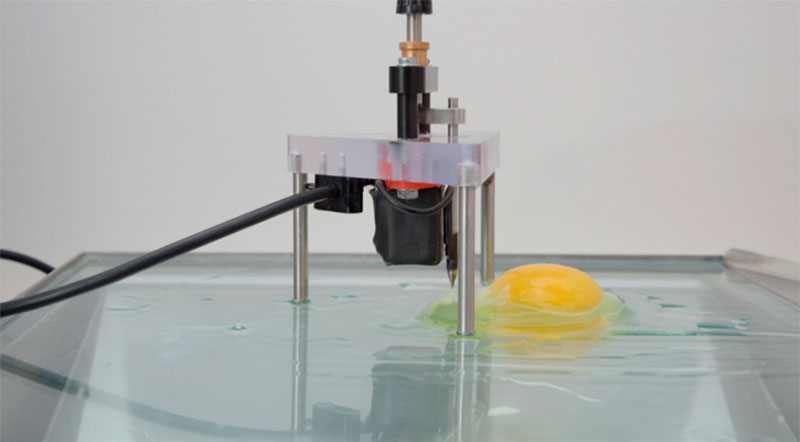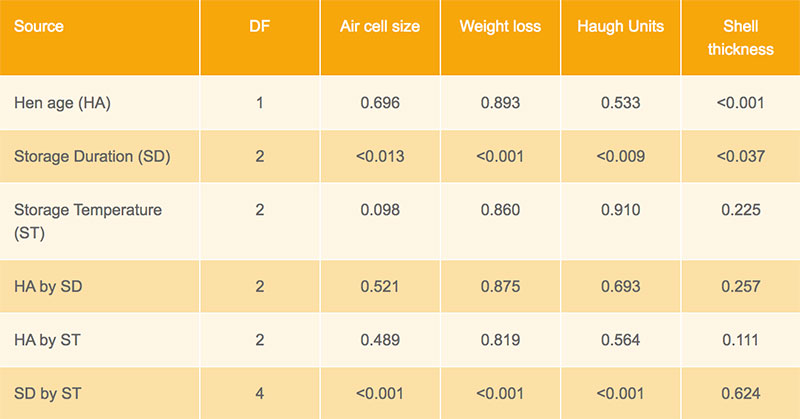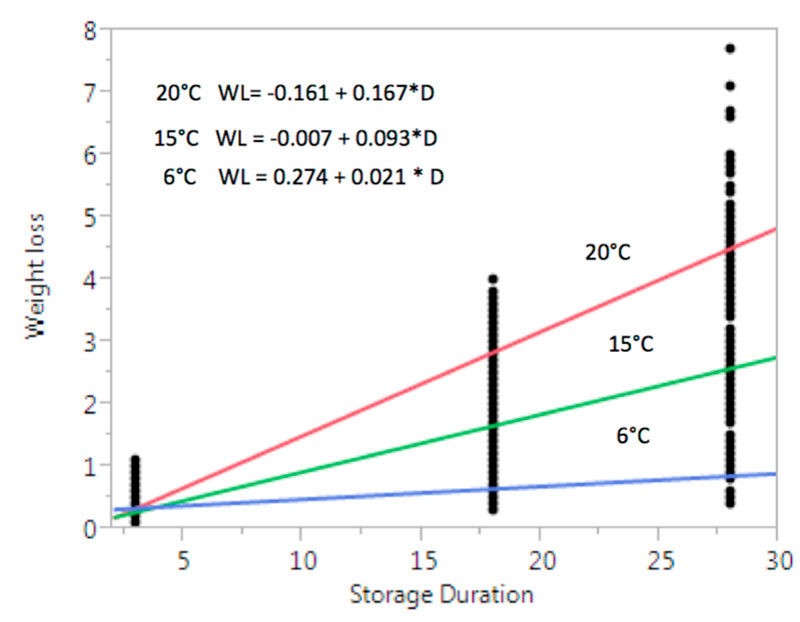Abstract
Freshness of eggs is a major concern of the consumers. The main criteria of freshness are Haugh Units, weight loss and air cell size. It was the aim of the present study to predict the development of these criteria in response to the main influencing factors: storage temperature, storage duration and hen age. A sample of 569 eggs from two flocks of a commercial white egg strain , 35 and 65 weeks of age and kept under the same management and feeding conditions, was assigned to two treatments: storage temperature (6, 15 and 22 °C) and storage duration (3, 18 and 28 days). Weight loss, air cell size, Haugh Units, shell thickness and yolk color were recorded at 3, 18 and 28 days of storage. Data was analysed using a complete three-factorial design with batch as block and hen age, storage temperature, storage duration and their interactions as effects. Multiple regression was used to analyze the response of the criteria to storage duration and temperature. There was a small but significant reduction of egg shell thickness in response to hen age. Air cell size, weight loss and Haugh Units were significantly influenced by storage duration and the interaction of storage duration with storage temperature. There was only a slight increase in air cell size and weight loss at 6 °C storage temperature. The response was much higher at 15 and 22 °C. Haugh Units decreased with increasing storage duration and storage temperature. The probability that air cell size exceeded 6 mm (the critical limit for grade A eggs) was calculated by logistic regression. More than 10 percent of eggs with air cell size larger than 6 mm will be expected from eggs stored for extended periods even at low storage temperature. Both weight loss and air cell size may cause problems of compliance with existing marketing regulations. The present data can be used to predict changes in egg weight, air cell size and Haugh Units within the range of 28 days of storage and at temperatures from 6 to 22 °C.
Keywords
egg quality, hen age, storage duration, storage temperature
Introduction
Chicken eggs are of excellent nutritional value for human consumption and the only food of animal origin which can be stored for several weeks in their natural condition without losing specific characteristics. The ability of eggs to be stored for several weeks evolved through their function as source of nutrients for the developing embryo. Under natural conditions the hen collects a clutch of about 10 eggs before starting to brood. Therefore, the egg content has to be protected against spoilage for more than a week before brooding begins and another three weeks until the chicks hatch. Most nutrients for the embryos are located in the egg yolk. The albumen`s main functions are to supply water and to prevent microbes from entering the egg and multiplying. In addition albumen protects the embryo against mechanic insults. The yolk and albumen are enclosed by the eggshell, which allows the exchange of carbon dioxide, oxygen and water through its pores. The eggshell has about 10,000 to 20,000 cone shaped pores with the smaller diameter at the inner position. The cuticle on the surface of the mineral shell contains proteins, polysaccharides and lipids. Inside the pores the cuticle material forms a block which closes the opening. This arrangement allows the exchange of gases and at the same time prevents intrusion of microbes. An intact cuticle is therefore of utmost importance for the shelf life of eggs. According to EU regulations, eggs of class A must have an intact cuticle and the air cell must not be larger than 6 mm. It is assumed that eggs stored up to 4 weeks still comply with the regulations, and the shelf life (best-before date) printed on retail egg packages is 28 days after packing. However, the effect of storage temperature and humidity during storage should be taken into account. Low temperature and high carbon dioxide (CO2) concentration during storage may be used to minimize the enlargement of the air cell (Scholtyssek, 1988), but the albumen height will decrease continuously even at low storage temperature and increased CO2 content of the surrounding air. As water and CO2 escape through the egg shell, pH of the albumen increases. The binding capacity of ovomucine and lysozyme decreases with storage time, resulting in reduced viscosity of albumen (Acker and Ternes, 1994). The size of the air cell depends on the storage conditions and is thus not a reliable criterion for the age of the egg. Albumen height is more reliable in this regard, but depends on egg size. The commonly used “Haugh Units” are albumen height corrected for egg size.Other factors which influence the interior egg quality are egg size, egg shell thickness and hen age. These factors are often confounded. Eggs from older hens are usually larger and have thinner egg shells (Akyurek and Okur, 2014; Bozkurt and Tekerli, 2009; Maciel et al., 2011; Ramos et al., 2010; Sung Heon and Kying Woo, 2014). The nutrition of the hens, especially supply of calcium, phosphorus and vitamin D, influence eggshell thickness and resistance to breakage. Albumen quality mainly depends on genetic factors and can only be marginally influenced by nutrition. Low pH in the drinking water may improve albumen height. Organic acids in the feed however, do not affect this criterion (Grashorn and Simonovic, 2009). Respiratory diseases like infectious bronchitis and egg drop syndrome have negative effects on both eggshell thickness and albumen viscosity.
The present study of internal egg quality is focused on the effects of egg storage time and temperature at different hen ages?. The results can be used as reference data for the prediction of internal egg quality after storage.
Materials and Methods
A total of 569 eggs of grade A and weight class L (63–72g) from a barn system were used. 300 eggs from 35 weeks old and 269 from 65 weeks old LSL Classic hens were obtained for the study. Both flocks were kept in the same farm and under the same feeding and management conditions. The study involved two collection days (batches). At arrival in the laboratory, 45 eggs were assigned to each of three storage temperatures (22, 15 and 6 °C) and three storage durations (3, 18 and 28 days). Treatments and number of eggs are shown in table 1.Eggs should not be kept below 5 °C at any time, and since it is not compulsory to cool eggs in the EU, retailers may keep them under moderate cooling at about 15 °C. The low temperature of 6 °C corresponds to the EU regulation EG 589/2008, which defines 5 °C as minimum storage temperature for eggs, plus a safety margin of 1 °C; the high temperature of 22 °C corresponds to room temperature. Large refrigerators with air exchange were used for the lower temperatures.
The first analysis was carried out 3 days after oviposition. At this age the eggs should qualify as “extra fresh”, i.e. the air cell size should not exceed 4 mm. The next level of storage duration, 18 days, corresponds to the EU regulation that eggs can only be sold until that age without prior cooling, while 28 days storage corresponds to the “best-before” date printed on egg cartons. Measurements on each egg included egg weight, air cell height, shell weight, shell thickness, Haugh Units and egg yolk color (DSM fan). Haugh Units were calculated according to the following equation (Haugh, 1937; cited by Wells, 1968):
HU = 100log (h – 1.7G 0.37 +7.6) where HU = Haugh Unit; h = albumen height (mm-2); G = egg weight (g)
Table 1: Mean initial egg weight (N) of the two batches and flock age


Fig. 1: Measurement of albumen height (Photo LTZ)
Statistical analysis
A preliminary check for normal distribution confirmed that none of the traits except yolk color deviated significantly from normality. The data were then subjected to a 3-factorial analysis of variance, with batch as blocked variable, hen age (35 and 65 weeks), storage duration (3, 15 and 28 days) and storage temperature (6, 15 and 22 °C) as main effects and all interactions between the three effects. A 2-factorial analysis of variance was conducted for the initial egg weight of the two batches and age groups. When the F-tests of the analysis of variance showed significant effects (P > 0.05) for the factors or interactions, the respective means were tested using Student´s t-test. Yolk color was analysed using ordinal logistic regression. Multiple linear regressions for weight loss, air cell height and Haugh Units were fitted in response to storage duration and temperature. The probability that air cell height exceeded 6 mm with increasing storage duration and temperature was estimated using nominal logistic regression and inverse prediction. The software JMP/SAS 11 was used for the statistical analysis.Results
Initial egg weight on the day of egg collection and sample size are shown in table 1. A preliminary 2-factorial analysis of variance revealed that the eggs of batch 1 were lighter than those of batch 2. Neither the effect of hen age nor of the interaction between both factors was significant. The results of the analyses of variance for air cell height, weight loss, Haugh Units and eggshell thickness are shown in table 2. The effect of batch was significant for all criteria except yolk color. Hen age showed a significant effect only on shell thickness. Storage duration significantly influenced air cell height, weight loss, Haugh Units and shell thickness but not yolk color. Significant interaction effects on air cell size, weight loss and Haugh Units were found between storage duration x storage temperature, hen age x storage duration and storage temperature.Table 2 Results of the analysis of variance: Degrees of freedom (DF) and p-values-values of the different variance sources


Figure 2 Linear regressions of weight loss (g) in response to storage duration (days) and temperature (6, 15 and 22 °C)
Table 3 shows the eggshell thickness (with shell membranes) for different hen age and storage duration. There was a slight but significant decrease of shell thickness in 65 weeks old hens versus 35 weeks old hens. Shell thickness decreased continuously with storage duration in both age groups; the difference between 3 and 28 days storage was significant. This reflects the shrinkage if shell membranes during storage. Weight loss increased linearly with storage duration, and the slope was steeper at 15 and 22 °C than at 6 °C (figure 2). The linear fit showed a high coefficient of confidence at 15 and 22 °C storage temperatures but not at 6 °C. The means per storage temperature and storage duration are shown in table 3.
Table 3 Egg shell thickness (means in μm-2) in response to hen age and storage duration

Means with different letters differ significantly (p-0.05)
Up to 3 days of storage, storage temperature had no significant effect. During 18 and 28 days of storage, weight loss increased significantly with storage temperature. When the eggs were stored at 6 °C the weight loss did not exceed 1 g, but at 15 and 22 °C weight loss reached 2.58 g and 4.54 g respectively. Air cell size and Haugh Units showed a similar response to storage temperature and storage time as weight loss (figures 3 and 4).
When the eggs were cooled at 6 °C, average air cell size remained below 4 mm at 28 days of storage. At 22 °C the average air cell size exceeded 6 mm after 25 days of storage. The Haugh Units changed only marginally with storage time at 6 °C storage temperature. The slope was moderate at 15 °C and very high at 22 °C. Since the individual egg quality varies considerably within the experimental groups, the means are unreliable criteria of quality. The probability that the critical limit of 6 mm air cell size is exceeded was therefore calculated using nominal regression. The percentage of eggs exceeding 6 mm are presented as predicted values for a range of storage temperature from 6 to 22 °C. The results are shown in figure 4. Up to 10 days of storage the probability that the air cell size is greater than 6 mm was close to zero for all storage temperatures. Thereafter the air cell size increases exponentially.. All regressions had high coefficients of determination between 0.92 and 0.99.
Discussion
Consumers consider freshness as the most important criterion of egg quality. “Freshness” implies a short time from the day of oviposition to egg consumption and is usually measured in terms of the size of the air cell or Haugh Units. Since the air cell is easy to measure, it has become the main criterion to check the freshness of eggs. Weight loss may also be considered as a criterion, but is difficult to determine under practical conditions. Awareness of possible weight loss during storage is important from a marketing point of view, because eggs are graded soon after oviposition and may reach the consumer at a lower weight than declared on the egg package/carton. The present data show that weight loss is negligible when the eggs are stored at low temperature but will increase significantly if they are not kept in the cold store.Weight loss and increase of the air cell are caused by the diffusion of water through the eggshell. The permeability of the eggshell depends on the thickness of the shell, number of the pores and the quality of the cuticle. Since shell thickness declines with hen age and egg weight, the latter factors are usually reported as causes of weight loss and increased size of air cell. Egg shell thickness decreased significantly with increasing hen age (table 3). Eggshell thickness was also negatively influenced by storage duration. This effect has not been observed in other egg storage experiments (Ramos et al., 2010; Maciel et al.,2011) and may be caused by shrinking of the inner egg membrane and/or cuticle. The magnitude of the changes in egg shell thickness was, however, very small and even at a hen age of 65 weeks shell thickness still exceeded 400 μm. In other experiments (Batkowska et al., 2014) thinner egg shells have been reported even in younger hens. Hen age in the present experiment showed no significant effect on weight loss and air cell size. This is in contrast to other studies (e.g. Bozkurt and Tekerli, 2009) and probably due to the fact that eggs of the same weight class have been used and age effect was not confounded with egg weight. Size of the air cell is a key criterion in the determination of egg freshness. According to EU marketing regulations eggs of grade A should have an air cell size of less than 6 mm. Only 7 percent of the eggs are allowed to exceed 6 mm when the eggs are checked at point of sale. The regulations assume that air cell size and other quality criteria will not change significantly within a storage time of 28 days. However, as our results show, air cell size remains small through 28 days of storage only if the eggs are kept at 6 °C, but increases rapidly at 15 and 22 °C. When kept at 22 °C room temperature, the mean air cell size exceeded 6 mm after 3 weeks of storage (figure 2). The increasing percentage of eggs with air cell size over 6 mm can be estimated using nominal regression procedures. The risk of exceeding the critical size is close to zero at all temperatures within the tested range. The critical value of 7 percent of eggs exceeding 6 mm is approached at 15 to 25 days of storage, depending on storage temperature. At 28 days of storage at 22 °C more than 10 percent of the eggs are predicted to have air cells greater than 6 mm, which may be claimed by the controlling authorities. Haugh Units as criterion for inner egg quality and freshness are determined by the stability of the protein chains of the albumin (Acker and Ternes, 1994). During storage, CO2 passes through the pores of the eggshell, the pH of the albumen increases, the complex forming capacity of ovomucine and lysozyme deteriorates, and the viscosity and Haugh Units decreases. In the present study, the Haugh Units remained close to 70 throughout the experiment when the eggs were stored at 6°C. This value is considered acceptable, but rather low for fresh eggs. Haugh Units decline rapidly with storage duration at 15 and 22 °C. The slope of the regression in figure 3 shows that the negative effect of storage duration at 22 °C on Haugh Units is even more pronounced than on weight loss and air cell size. The decline of Haugh Units can also be considered an indicator of reduced lysozyme activity (Trziszka, 1994), known as important agent to protect the egg contents against microbial contamination.
Conclusions
The main factors influencing internal egg quality are duration and temperature of storage, and there is a significant interaction between these two factors. Within 28 days of storage the changes in egg weight, Haugh Units and air cell size are not critical if eggs are kept at 6 °C, but there is a rapid loss of quality at temperatures of 15 and 22 °C. Haugh Units change more rapidly at high temperatures than air cell size. There is a significant decrease of egg shell thickness with increasing hen age. The critical limit for grade A eggs, i.e. the probability of exceeding 6 mm air cell size, is predicted for 10 percent of the eggs at 17 days when stored at 20 °C or at 25 days when stored at 6°C. Degradation of internal egg quality may be faster when other factors, such as disease or inadequate nutrition compromise shell quality. Cooling of eggs from the beginning of storage is therefore recommended whenever eggs are not sold and consumed within short time.
References
Acker, L., W. Ternes (1994) Physikalisch-chemische Eigenschaftsveränderungen bei der Alterung von Hühnereiern. In Ternes, Acker und Scholtyssek: ‚Ei und Eiprodukte‘. Paul Parey Verlag Berlin und Hamburg, ISBN 3-489-63114-5, 322-328.Akyurek, H., A.A. Okur (2009) Effect of storage time, temperature and hen age on egg quality in free-range layer hens. J. Anim. Vet. Adv. 8: 1953-1958.
Batkowska, J. (2014) Quality of laying hen eggs during storage depending on egg weight and type of cage system (conventional vs. furnished cages). Ann. Anim. Sci. 14, 707-719.
Bozkurt, Z., M. Tekerli (2009) The effects of age, genotype and temperature of storage on egg quality. Kafkas Üniversitesi Veteriner Fakültesi Dergisi 15(4): 517-524.
Grashorn, M.A., S. Simonovic (2009) Wholesome drinking to prevent watery eggs. World Poultry 25(6): 18-19.
Maciel, W.C., A. Daza-Andrada, A. Callejo Ramos, R.S. de C. Teixeira, C.B. Carbo (2011) Effect of hen age, egg weight and storage system on physical properties of egg from white-egg laying hens. PUBVET 5(32)
Ramos, A.C., W.C. Maciel, A.D. Andrada, R.S. de C. Teixeira, C.B. Carbo (2010) Effect of bird age and storage system on physical properties of eggs from brown laying hens. PUBVET 4(37)
Scholtyssek, S., 1988: Die Einflüsse der Lagerung auf die Qualität von Frischeiern. DGS 40: 303–308.
Sung Heon, C., L. Kyong Woo (2014) Effect of hen age, storage duration and temperature on egg quality in laying hens. Int. J. Poult. Sci. 13: 634-636.
Trziszka, T. (1994) Lysozyme and its functions in the egg. Arch. Geflügelk. 58: 49-54.
Wells, E.G. (1968) The measurement of certain egg quality characteristics: a review. In T.C. Carter ‘Egg quality: a study of hen’s egg’. Oliver & Boyd Edinburgh, 207-250.







